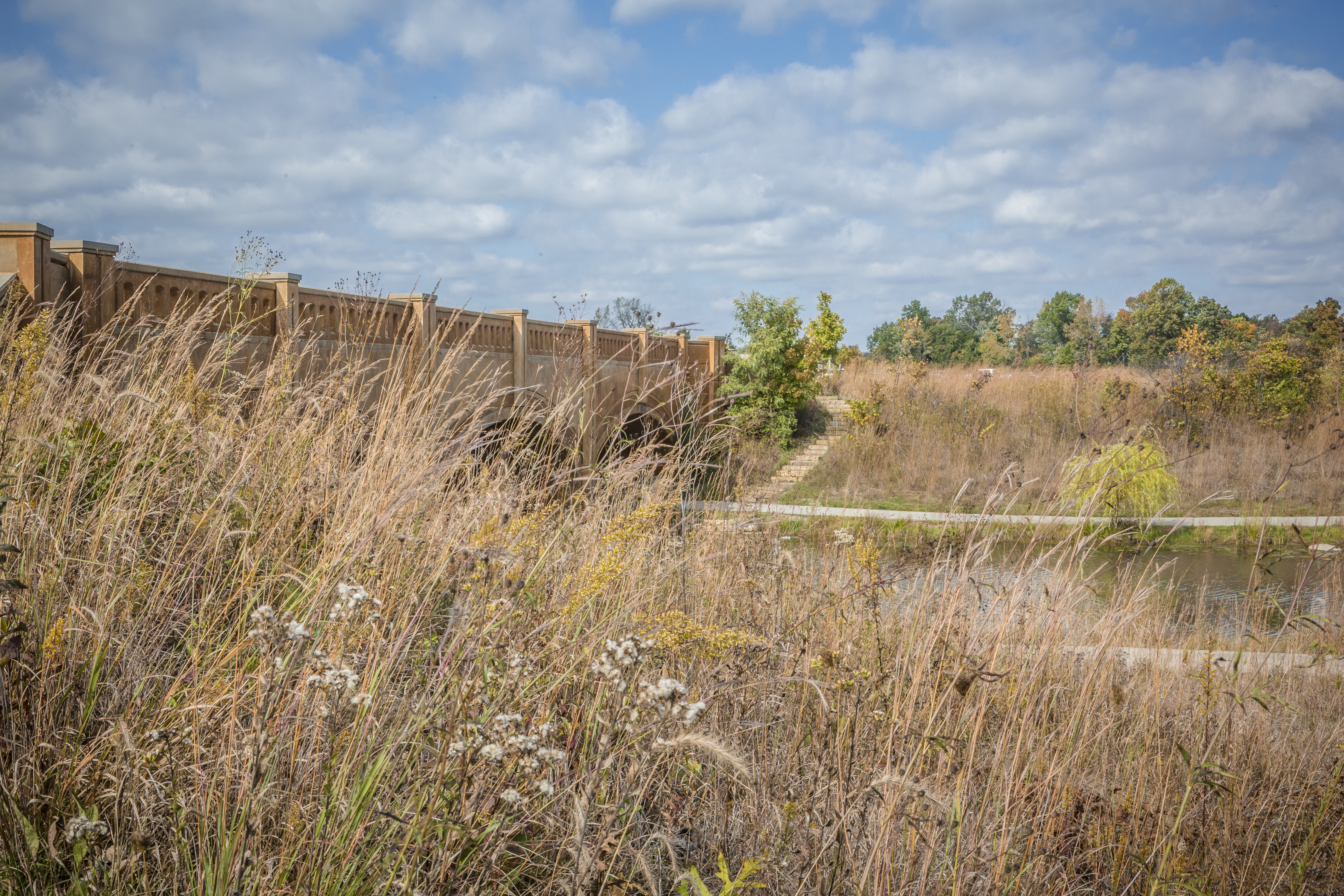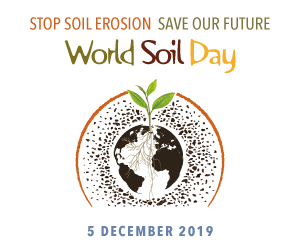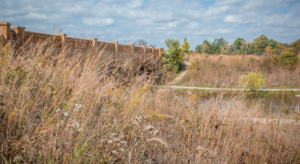
Brittany McAdams, our natural resources coordinator, shares what erosion is and what you can do to help
By: Brittany McAdams
Happy World Soil Day! Today we celebrate soils as the (literal) foundation of life—they form the ground we stand on, build our homes on, and plant our gardens in. Each day soils support our lifestyles by providing our food, filtering our water, housing staggering biodiversity of organisms, supporting the growth of plants that clean the air we breathe … the list goes on.
 The Food and Agriculture Organization of the United Nations (FAO) recognizes World Soil Day every year on December 5. This year, the theme of World Soil Day is “Stop soil erosion, Save our future” and I couldn’t be happier! You may not know this, but I love soil. I studied soil science at Purdue University and earned my master’s in soil science at the University of Alberta. Soil erosion is an issue as old as time, and there are many ways you and Carmel Clay Parks & Recreation can prevent soil erosion. Let’s dig in.
The Food and Agriculture Organization of the United Nations (FAO) recognizes World Soil Day every year on December 5. This year, the theme of World Soil Day is “Stop soil erosion, Save our future” and I couldn’t be happier! You may not know this, but I love soil. I studied soil science at Purdue University and earned my master’s in soil science at the University of Alberta. Soil erosion is an issue as old as time, and there are many ways you and Carmel Clay Parks & Recreation can prevent soil erosion. Let’s dig in.
What is soil erosion?
To prevent soil erosion, you have to know what it is! Soil erosion is the detachment and movement of soil by wind, water and human activity. It occurs naturally but is enhanced by human activities. I think it’s said best by Charles Kellogg in The Soils That Support Us (1956):
“Each soil has its own history. Like a river, a mountain, a forest, or any natural thing, its present condition is due to the influences of many things and events of the past.”
This rings very true for soil erosion. Nature and our land management practices influence this complex issue. The decisions we make today to conserve our soils will influence the quality and quantity of our soil resources for generations to come.
When it comes to soil erosion, there are two main forces at work: Wind and water. We’ll discuss each type of erosion and what causes it, how parks are working to prevent it, and what you can do at home to prevent it. When working to prevent soil erosion, we use tactics called Best Management Practices (BMPs). In the end, you’ll see there is one practice above all that we can all implement to preserve our valuable soil resources.
Wind Erosion
Wind erosion is when soil particles are detached, transported, or deposited by wind, often depositing soil particles were they don’t belong in water bodies (Know Soil, Know Life, 2012). This may not seem like a big issue, but the soil eroded by the wind at the ground surface is our rich, organic topsoil. Losing topsoil means our agricultural fields and gardens are less productive, and our soil isn’t able to hold as much water and mineral soil particles. In fact, one of the worst environmental disasters in our history was the loss of soil during the Dust Bowl of the 1930s. The culprit? Wind erosion. So, how can we prevent this? The solution is implementing BMPs, like maintaining covered ground surfaces, using cover crops, crop residues – like stems, leaves and roots – reduced- or no-till systems, and installing windbreaks.
In the Parks:
 We utilize covered surfaces across our parks, and we plant plants that have deep perennial roots for sustainable, long-term cover. Think of the prairies out at West Park or Central Park. The roots of plants like warm-season grasses, compass plant, purple coneflower, and leadplant descend several feet into the soil. This creates an intricate network of roots that hold on to soil and help develop structure. Ground cover is vital even at the restoration stage of these prairies, like out at Jill Perelman Pavilion. Planting a cover crop is essential. You’ll often see us planting oats or rye prior to seeding during the growing season and using straw to maintain cover throughout the winter.
We utilize covered surfaces across our parks, and we plant plants that have deep perennial roots for sustainable, long-term cover. Think of the prairies out at West Park or Central Park. The roots of plants like warm-season grasses, compass plant, purple coneflower, and leadplant descend several feet into the soil. This creates an intricate network of roots that hold on to soil and help develop structure. Ground cover is vital even at the restoration stage of these prairies, like out at Jill Perelman Pavilion. Planting a cover crop is essential. You’ll often see us planting oats or rye prior to seeding during the growing season and using straw to maintain cover throughout the winter.
At Home:
Maintain cover across your land throughout each season, especially when it comes to garden maintenance. Keep plant residues – like roots, stems and leaves – in your garden throughout the winter to help prevent soil loss. This will not only keep your garden soils in place, but it will also help create rich, productive soil for next year’s garden.
Water Erosion
Water erosion is caused by two main detaching forces: Rain impact and flowing water (Know Soil, Know Life, 2012). It is more visible than wind erosion—you can see it as rill erosion (small water channels easily crossed by tractors) and gully erosion (large water channels not passable by tractors). Another place you’re likely to see water erosion is along the shoreline of streams and riverbanks. After a big rainfall, the amount of water running through a creek increases, speeding up water flow, picking up soil particles and bringing them downstream. This results in an eroded and unstable streambank and ultimately a loss of soil. The solution is implementing BMPs, like reduced- to no-till systems, using cover crops, maintaining vegetated waterways (think bioswales), and using things like strip cropping.
In the Parks:
Water erosion is an ongoing challenge in our parks, particularly those with streams running through them like Cool Creek at Flowing Well Park and Carmel Creek at Central Park. Through our “Reimagining Parks” campaign (read more about that here!) we will re-establish the Cool Creek bank in Flowing Well Park. Over the years, the bank has been severely eroded. Priority areas are places where the creek bends. Creek bends cause the water channel to narrow and add momentum to the water flow along the outside edge. Ultimately, this causes major stability issues. This bank re-stabilization project, scheduled for spring/summer 2020, will restore eroded areas to preserve one of our most precious parks. Managing our creek bank for water erosion is just the next step in sustaining this park for generations to come!
At Home:
The best thing you can do to prevent water erosion at home is to keep the ground covered! One way is to keep residues (Remember this from before? It’s stems, leaves and roots) on your garden year-round. It’s also important to ensure all waterways and portions of your yard have – at a minimum – grass in them. If you have a stream, creek or pond, make sure you keep edges vegetated. Similar to mitigating wind erosion, keeping the soil covered with plants that have deep roots help your soil retain its structure when it’s impacted by water.
The ultimate solution? Ground cover!
Whether you’re dealing with soil erosion by wind or water, the best (and easiest) solution is to keep your soil covered. Just one more thing to keep in mind—only use native groundcover. There are many non-native groundcovers like wintercreeper and periwinkle, so make sure you are only planting native. This helps prevent soil erosion and helps attract native animals and insects to your yard year-round. It also prevents the spread of invasive species in Indiana!
Citations
Know Soil, Know Life, David L. Lindbo, Deb A. Kozlowski, & Clay Robinson, Editors Soil Science Society of America, 2012 www.soils4teachers.org
